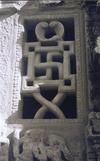Swastika in Indian Culture
by Jyotsna Kamat
First Online: February 26, 2003
Page Last Updated: December 07, 2024
 The name Swastika brings to mind very bitter memories of World War II. It was
symbol of Hitler's Nazi Germany. At the time it represented Aryan superiority
over all other races in the world according to the Nazis.
The name Swastika brings to mind very bitter memories of World War II. It was
symbol of Hitler's Nazi Germany. At the time it represented Aryan superiority
over all other races in the world according to the Nazis.
But in the Indian context, the swastika stands for universal welfare. "Swasti" means well-being of one and all, "ka" means symbol. Vedic literature is full of such prayers.
The origin of swastika symbol is rooted in hoary past. It appeared as a holy symbol in Mesopotamia, Babylonia, and ancient Greece in similar designs. Variations are also noticed in South and Central American (native American) relics. All these point out to some ancient, common religious rite used by ancient man for invoking a powerful deity, mostly connected with prosperity.
The Swastika is the most auspicious symbol in Buddhist, Jaina, and Hindu traditions. For every holy occasion, swastika symbol is drawn or painted, carved, or sculpted at the place of worship. To signify birth, marriage, or any joyous occasion, Rangoli of swastika forms constitute essential decoration. Swastika indicates happiness, safety, fertility, and prosperity. In the Indian ethos, all these are considered as blessings of Sun god, and we can say that swastika symbol is representation of Sun.
Indian philosophers have attributed the four corners of the swastika to the four purushärthanas (aims of life) namely dharma, artha, kama, and moksha -- of life and the perfectly symmetric shape to indicate the balance. The four stages in a man's life -- brahmacharya (celibacy), grihastha (householder), vanaprashta (seclusion), and sanyasa (renunciation) are also said to represent the corners, and the life being the one connecting them in a brilliant embrace.
Some scholars have traced the origins of the Holy-Cross to the swastika symbol.
![]()
See Also:
- Hinduism Potpourri -- Hindu mythology, point of views, pictures of deities, sages and stories.
- Search for more Pictures of Swastika in Kamat PictureSearch



